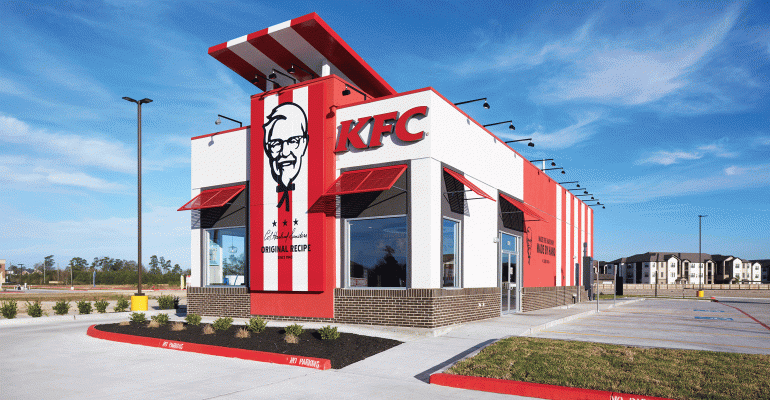We have written at length about the intensifying competition in the chicken category driven by the accelerating demand for all-things-chicken from consumers. And, for the past several quarters at least, KFC U.S. has been a beneficiary of that rising demand — experiencing positive same-store sales growth in five of the past eight quarters.
Until Q1 2024, in which the chain reported Wednesday that same-store sales were down by 7%, the only other negative same-store sales quarter for the U.S. system in the past two years came in Q2 2022, when it lapped its wildly successful chicken sandwich launch from 2021.
That said, prior to Q1, its most recent quarters — Q3 and Q4 2023 — were flat while lapping low-single-digit quarters from 2022, not necessarily tough comparisons by most definitions. This flatline-to-decline has come despite a busy cadence of new menu news, including chicken sandwich iterations, and value-friendly wraps and bowls that have proven to attract younger consumers.
Apparently not enough of them, however. Recently released data from Placer.ai found that during March, visits declined at KFC U.S. by over 12%. We have a general traffic erosion problem at most concepts in this industry right now, but -12% takes the cake.
KFC’s traffic has struggled throughout the past two quarters, down in the low-single digits in Q4 and dipping to negative 7.5% in January, which was a tough month for most concepts due to bad weather. Visits bounced up slightly in February, to negative 6.2% before dropping off significantly in March, according to Placer.ai’s data.
Yum executives didn’t dive into traffic patterns during the company’s Q1 call, but CEO David Gibbs did acknowledge, “the KFC brand in the U.S. has been struggling.” He attributed the same-store sales decline to unfavorable weather and “chicken value promotions” from QSR competitors, adding that Yum is “excited about some of the work going on behind the scenes to really boldly reset the brand in the U.S.”
He didn’t disclose what that work included, other than to say it will pull from the playbook of its international business which he said is “on fire.”
“We know how to bring that brand to life to connect with consumers around the world and we have to do a better job of that in the U.S.,” Gibbs said. “It’s a high priority for us as we move forward.”
Something KFC International’s business doesn’t contend with as much, however, is that aforementioned competitive landscape, which is likely KFC U.S.’s biggest challenge. Indeed, RJ Hottovy, head of analytical research at Placer.ai, said KFC’s visits have struggled from the brand’s position in a tough category.
“Chicken is a highly competitive space, more than it has ever been. You’ve got Chick-fil-A, Raising Cane’s, and the up-and-coming brands like Dave’s Hot Chicken,” Hottovy said during a recent interview. “It’s a space I feel like people are looking for more variety and they’re getting it elsewhere. There are more places for them to do so.”
Traffic data corroborates as much. While KFC’s visits dropped, Popeyes experienced positive quarterly visit growth in Q1 2024, including a nearly 13% increase in February. Popeyes’ comp sales were up 5.7% in Q1. Wingstop, which reported shortly after Yum Brands, experienced a same-store sales increase of nearly 22%. Placer.ai data shows that visits to Wingstop were up by over 23% in Q1.
For the private companies, Technomic Ignite data from 2023 shows some sales growth disparities among KFC and its domestic competitors. Chick-fil-A’s sales were up by 14.7% on the year, while Bojangles was up 10% and Church’s Chicken was up 5.6%. Raising Cane’s grew sales by over 20% in 2023.
In comparison, KFC U.S. sales increased by just 1.7% year-over-year.
Then there are the emerging chains, like Dave’s Hot Chicken, Slim Chickens, and Jollibee all of which are picking up their domestic development pace and providing that variety Hottovy insists more consumers are looking for. Perhaps KFC’s late March saucy nuggets launch will provide a tailwind for the company in Q2 as more consumers seek out unique sauces. Or, perhaps pulling from that international playbook – whatever that may entail – will do the trick.
It might be worth noting, however, that many chicken brands are also pushing the gas on international as consumer demand translates globally. Slim Chickens just signed a 20-unit deal in Germany, for instance, while Big Chicken is targeting the UK, Canada, and Central America. Meanwhile, Wingstop is eyeing 7,000 international locations, and Popeyes has entered 18 new countries since 2018. Of course, these concepts have a long way to go to catch up to KFC’s 30,000-unit global footprint, but they’ve proven their competitive worth in the U.S. and could feasibly do so overseas at some point as well.
Contact Alicia Kelso at [email protected]




